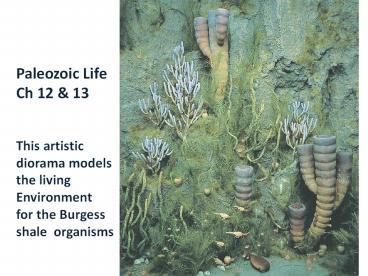Ch 12 Paleozoic Life - PowerPoint PPT Presentation
1 / 26
Title:
Ch 12 Paleozoic Life
Description:
would slump and down the escarpment as a turbidity current. At the base, ... Mass Extinctions. Mass extinctions, those geologically rapid events . – PowerPoint PPT presentation
Number of Views:88
Avg rating:3.0/5.0
Title: Ch 12 Paleozoic Life
1
Paleozoic Life Ch 12 13 This artistic
diorama models the living Environment for the
Burgess shale organisms
2
Visible Life
In the Cambrian system of rocks, a large number
of visible complex species were observed. Life
had been single-celled simple organisms for
billions of years. The sudden appearance of
large, well-preserved organisms caused scientists
to use the term Cambrian Explosion Not so fast
the Cambrian period lasted for 54 million
years. Life appeared to evolve more rapidly but
there had been many steps Leading to the new life
forms. The Ediacara fossils were multi-celled
soft-bodied predecessors Increase in oxygen may
be responsible for increase in body size.Ocean
chemistry was evolving and may have increased in
calcium. Cambrian continents were apart allowing
more marine habitat. Sauk transgression created
more shallow marine habitat on shore. Global
warming was occurring.
3
Emergence of shelly faunaThis Cambrian fossil is
a few mm
4
What are advantages to having an exoskeleton?
Protection from UV light, allowing organisms into
shallow waters Prevents drying out in intertidal
locations Supporting skeleton (shell) allows for
increased size and attachment of
muscle Protection from predators
5
Cambrian predatoranamalocoris
6
Olenellus, a Cambrian trilobiteshows signs
healing wounds
7
Marine ecosystem plankton (phyto- zoo-),
nekton, benthos, sessile, mobile, epifauna,
infauna
8
Marine Ecosystem
- Where and how animals and plants live in the
marine ecosystem
Plankton Jelly fish
Nekton fish cephalopod
Sessile epiflora seaweed
Sessile epifauna bivalve
Benthos d-k
crinoid
coral
9
Marine Ecosystem
Mobile epifauna gastropod, starfish
Infauna worm, bivalve
10
Marine Ecosystem
Suspension feeders
coral
crinoid
bivalve
11
Marine Ecosystem
Carnivores-scavengers starfish
worm sediment-deposit feeder
Herbivores gastropod
12
(No Transcript)
13
Trilobites Conspicuous Cambrian fossils
Fig. 1, p. 248
14
Agnostus Believed to be blind Other
trilobites have Compound eyes
Fig. 3, p. 249
15
Fig. 6, p. 249
16
Fig. 5, p. 249
17
Middle Ordovician
Fig. 12-9, p. 251
18
Late Ordovician
Fig. 12-11a, p. 252
19
Fig. 12-11b, p. 252
20
Fig. 12-12a, p. 253
21
Middle Devonian Reef Buildiers
22
Middle DevonianNew York State Eurypterid
Fig. 12-14, p. 254
23
Late Devonian Ammonoid
Fig. 12-15, p. 254
24
Fig. 12-16, p. 255
25
Fig. 12-19, p. 257
26
http//www.youtube.com/watch?vs1xfRc4SDswNR1fe
aturefvwp

